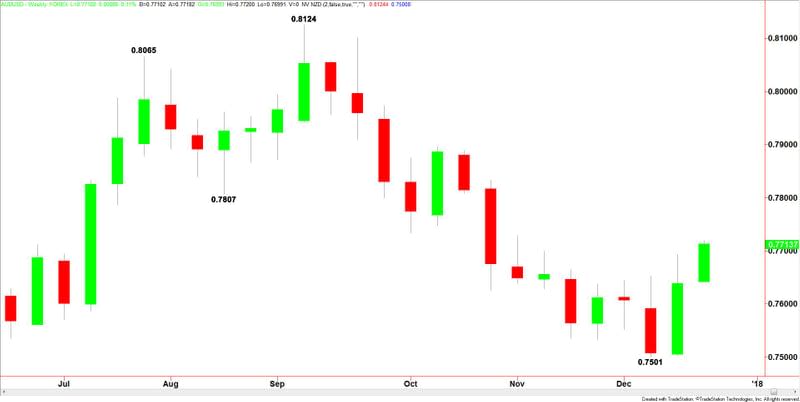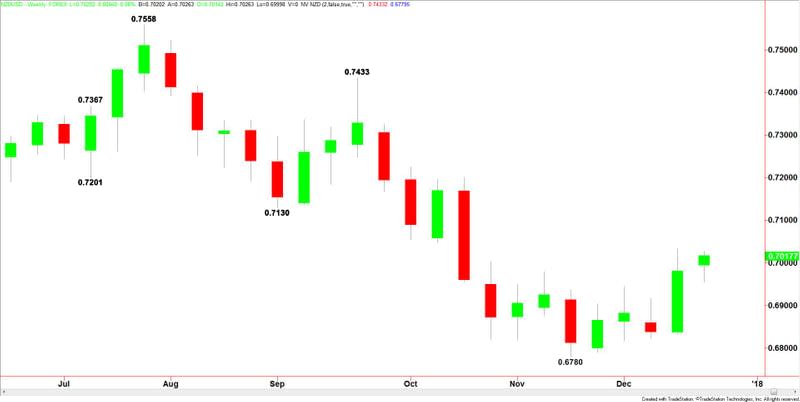AUD/USD and NZD/USD Fundamental Weekly Forecast – Volume to Remain Below Average Until Start of New Year
The Australian and New Zealand Dollars posted solid gains last week with the Aussie leading the way. Investors took advantage of oversold conditions, low pre-holiday volume and a weaker U.S. Dollar.
The AUD/USD settled at .7714, up 0.0075 or +0.98% and the NZD/USD finished the week at .7018, up 0.0036 or +0.52%.

In Australia, the Mid-year Economic and Fiscal Outlook came out in line with market expectations, showing smaller budget deficits for the current and next financial year. According to the outlook, the 2017-18 underlying cash deficit is seen at around AUD23.6 billion, from AUD29.4 billion at budget. The 2018-19 underlying deficit is expected to be AUD20.5 billion from AUD21.4 billion previously.
In addition, the consensus for a surplus in 2020-21 was maintained, albeit with a slightly healthier buffer. Improved balance projections have resulted in marginally lower net debt projections, which are expected to peak at a lower 19.2% of GDP, from a peak 19.8% at budget time in May, the report said.
In other news, the Reserve Bank of Australia’s December minutes provided some support for the Aussie Dollar, with the central bank pointing optimistically to strengths within the labor market, asserting that employment growth will continue to be ‘somewhat above average’ in the next few quarters.
The minutes also suggested that strong employment would eventually feed into higher wages and higher levels of inflation, (albeit at a slower pace). This could, potentially, result in rate hikes in the years ahead, although this remains entirely dependent on the extent that inflation rates rise.
In New Zealand, oversold conditions and optimism over the appointment of a new governor at the Reserve Bank of New Zealand continued to provide support.
Additionally, New Zealand posted a bigger-than-expected goods trade deficit in August as exports of milk powder, butter and cheese declined and imports of crude oil and petroleum products jumped higher.
The country had a trade deficit of $1.235 billion in August, little changed from the $1.24 billion deficit in August last year but ahead of the $968 million average monthly deficit in August over the last five years, Statistics New Zealand said. The deficit was bigger than the $825m median forecast in a Bloomberg survey of 10 economists.
In other news, New Zealand quarterly GDP came in at 0.6% as expected, however, this was below the upwardly revised previous estimate of 1.0%.
The widening of the differential between Australian and New Zealand Government Bond yields and U.S. Government Bond yields continued to remain supportive for the Aussie and Kiwi.

Forecast
This is a holiday shortened week so we are expecting light volume, however, this could lead to unexpected volatility. The major banks and institutions are likely to be on the sidelines until after the first of the new year.
In the U.S. on Wednesday, the Conference Board’s Consumer Confidence report is expected to come in at 128.2, down slightly from the previous 129.5. Thursday’s Weekly Unemployment Claims report is expected to come in at 241K.
Other reports include, S&P/CS Composite-10 HPI, the Richmond Manufacturing Index, Pending Home Sales, Goods Trade Balance, Preliminary Wholesale Inventories and Chicago PMI.
This article was originally posted on FX Empire

 Yahoo Finance
Yahoo Finance 